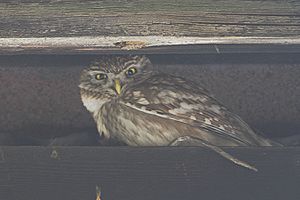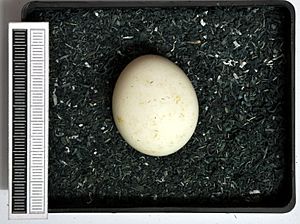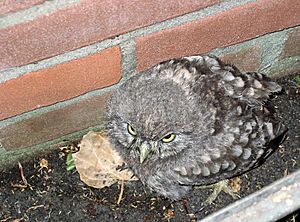Little owl facts for kids
Quick facts for kids Little owl |
|
|---|---|
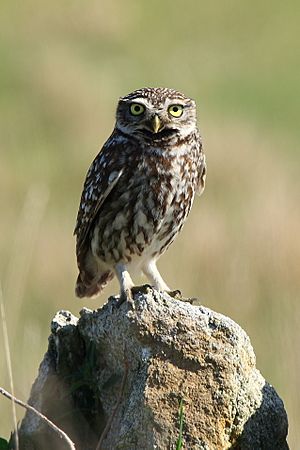 |
|
| Conservation status | |
| Scientific classification | |
| Kingdom: | |
| Class: | |
| Order: | |
| Family: | |
| Genus: |
Athene
|
| Binomial name | |
| Athene noctua |
|
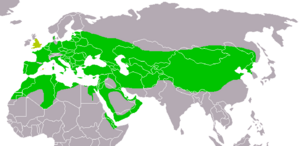 |
|
| Range of the little owl | |
The little owl (Athene noctua) is a small bird. It lives in the warmer parts of Europe, Asia (as far east as Korea), and North Africa. This owl was brought to Britain in the late 1800s. It also came to the South Island of New Zealand in the early 1900s.
This owl belongs to the group called Strigidae. Most owl species are in this group. The other main group of owls is the barn owls, called Tytonidae.
Little owls are small and have colors that help them blend in. They are mostly active at night. You can find them in many places, like farmland, the edges of woodlands, steppes, and even semi-deserts. They eat insects, earthworms, other small creatures without backbones, and small animals with backbones.
Male owls have their own areas, called territories. They protect these areas from other owls. Little owls build their nests in holes. The female lays about four eggs in the spring. She sits on the eggs to keep them warm. The male brings food to the nest. First, he feeds the female, then the baby owls. When the chicks grow, both parents hunt for food. The young owls leave the nest when they are about seven weeks old.
There are thirteen different types, or subspecies, of little owls. They are found all over Europe and Asia.
Contents
What Does the Little Owl Look Like?
The little owl is a small owl. It has a flat head, a round body, and a short tail. Its face looks like it's frowning because of how its eyes are shaped. Its feathers are grey-brown with white spots and stripes. Its belly is pale with darker stripes.
This owl is usually about 22 centimeters (8.7 inches) long. Its wingspan is about 56 centimeters (22 inches) for both males and females. It weighs around 180 grams (6.3 ounces).
The most common type of adult little owl is A. n. noctua. It is brown with white speckles on top. It is white with brown streaks underneath. It has a big head, long legs, and yellow eyes. Its white "eyebrows" make it look serious. Young owls are not as bright. They don't have the white spots on their heads like adults.
This owl flies in a bouncy way, like a woodpecker. But its wingtips are rounded, and it looks different overall. Owls change their feathers from July to November. Males start changing their feathers before females.
The little owl's call sounds like a questioning kiew, kiew. Sometimes, it makes whistling or trilling sounds. During the breeding season, they make more varied calls. A pair of owls might even call together. Near the nest, they make yelping, chattering, or barking sounds.
Where Do Little Owls Live?
Little owls are found across Europe, Asia, and North Africa. In Europe and Asia, they live from Spain and Denmark all the way to China. They also live south to the Himalayas. In Africa, they are found from Mauritania to Egypt and Arabia. These birds were brought to New Zealand and the United Kingdom. In the UK, they have spread across much of England and all of Wales.
This owl stays in one place and does not migrate. It lives in open areas with many different habitats. These include farms with hedges and trees, orchards, and the edges of forests. They also live in parks, gardens, steppes, and rocky semi-deserts. You can find them in treeless places like sand dunes. They also live near old buildings, quarries, and rocky areas. Sometimes, they even go into villages and towns.
In the United Kingdom, they mostly live in lowlands. They are usually found below 500 meters (1,600 feet). In Europe and Asia, they can live much higher up. One owl was seen at 3,600 meters (11,800 feet) in Tibet.
How Little Owls Live and Hunt
The owl often sits high up. It waits to dive down on any small creature it sees. It eats insects and earthworms. It also eats small animals with backbones. These include amphibians, reptiles, birds, and mammals. It might chase prey on the ground. It also hides extra food in holes or other secret spots.
Scientists studied the pellets that owls spit out. These pellets contain parts of food they can't digest. The study showed that mammals made up 20% to 50% of their diet. Insects made up 24% to 49%. The mammals they ate included mice, rats, voles, shrews, moles, and rabbits. They mostly ate birds during the breeding season. These were often young birds, including baby game birds. The insects included flies, earwigs, beetles, butterflies, and bees. Sometimes, they ate a small amount of plant material (up to 5%). This was probably eaten by accident.
Reproduction and Life Cycle
The little owl is territorial. The male usually stays in the same area for his whole life. But the size of his territory can change. It is largest during the spring when they are looking for a mate. The area where the owl hunts for food changes depending on the habitat and time of year. Owls that live in areas with many different habitats have smaller hunting grounds (less than 2 hectares). Owls in plain farmland have larger hunting grounds (over 12 hectares). Larger hunting grounds mean more flying, longer trips for food, and fewer visits to the nest.
If a male owl enters another male's territory, the owner will approach and make territorial calls. If the intruder doesn't leave, the owner will fly at him aggressively. If that doesn't work, the owner will attack again, trying to hit with his claws. When an owl retreats, it often drops to the ground and flies away low. Owls defend their territory more strongly against a strange male. They are less aggressive towards a male from a nearby territory that they know. This shows that little owls can recognize other birds by their calls.
This owl calls more at night as the breeding season gets closer in late spring. They nest in different places depending on where they live. Nests can be found in holes in trees, cliffs, quarries, walls, old buildings, river banks, and rabbit burrows. The female lays three to five eggs. Sometimes it's two to eight eggs. The eggs are oval-shaped, white, and not shiny. They are about 35.5 by 29.5 millimeters (1.40 by 1.16 inches).
The female sits on the eggs to keep them warm. She sometimes starts sitting after the first egg is laid. While she is incubating, the male brings her food. The eggs hatch after 28 or 29 days. At first, the female keeps the chicks warm. The male brings food, and she gives it to them. Later, both parents hunt and feed the young. The young owls leave the nest at about seven weeks old. They can fly a week or two later.
Usually, they have one group of chicks per year. But if there is a lot of food, they might have two. How much energy the chicks build up in the nest helps them survive after they leave. Stronger birds have a much better chance of survival. When young owls leave home, they usually don't go more than about 20 kilometers (12 miles).
Pairs of owls often stay together all year. Their bond can last until one owl dies. The little owl is partly active during the day. It often sits out in the open during the day. If they live near people, little owls can get used to humans. They will stay on their perch, even when people are around. A little owl can live for about sixteen years. However, many birds do not live that long. Harsh winters can be tough on them. Some owls are hit by cars at night. So, the average lifespan might be around three years.
Are Little Owls Safe?
The little owl (A. noctua) lives in a very large area. Experts think there are between 560,000 and 1.3 million breeding pairs in Europe. Europe makes up 25% to 49% of the owl's global range. So, the world population might be between five million and fifteen million birds. The number of owls is thought to be stable. Because of this, the International Union for Conservation of Nature says the bird's status is "least concern". This means they are not currently in danger.
Little Owls in History and Culture
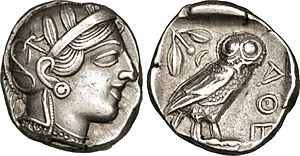
Owls have been shown in art since the Stone Age. They appear in statues, drawings, pottery, and wooden posts. But usually, they are just general owls, not a specific type. However, the little owl is strongly connected to the Greek goddess Athena and the Roman goddess Minerva. Because of this, it stands for wisdom and knowledge.
A little owl with an olive branch is on a Greek coin from 500 BC. A copy of this coin is on the modern Greek one-euro coin. A 5th-century B.C. bronze statue shows Athena holding the bird. People believed that the call of a little owl announced the murder of Julius Caesar. The owl's genus name, Athene, honors the goddess. Her original role as a goddess of the night might explain why she is linked to an owl. The species name noctua means the same thing. It is the Latin name for an owl sacred to Minerva, Athena's Roman equal.
In 1992, the little owl was used as a watermark. It appeared on Jaap Drupsteen’s 100 guilder banknote in the Netherlands.
Images for kids
-
Little owls often nest in hollow tree trunks (Strumpshaw Fen RSPB reserve, Norfolk)
See also
 In Spanish: Mochuelo europeo para niños
In Spanish: Mochuelo europeo para niños



